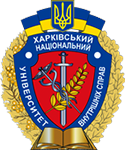The staffing problem in the police during 1943–1944 and ways to resolve it
Abstract
The state of police staffing during 1943-1944 is revealed, its peculiarities related to the course of the German-Soviet war are identified. The staffing problem in the police during the war was extremely acute. The mobilisation of police officers to the army, their deaths in combat, and evacuation to the east significantly worsened the staffing potential of this law enforcement body. The situation with recruitment in 1943–1944 changed somewhat compared to the first stage of the war. This process became more manageable and lost the main elements of chaos and situationalism that were characteristic of the initial period of the war. In the regions of Ukraine liberated from the Nazis, NKVD operational groups immediately began recruiting police officers. There were several sources of this formation: pensioners, women, demobilised soldiers and partisans, as well as officers seconded from other regions of the USSR. The educational level of newly recruited police officers was very low at the time. Thus, of those recruited to the state police, only 7.6 % had special training, 3.1 % had military education, and 10.6 % had a secondary education. A significant proportion of police officers had little work experience. For example, 45 % of the state police had less than 1 year of service, and almost 69 % of the departmental police had less than 1 year of service. By the end of 1944, the total percentage of police personnel reached 70.4%. The ethnic composition of the police was as follows: Ukrainians – 47.8%, Russians – 36.5 %, Jews – 15.4 %, and others – 0.3%. Due to the shortage of people, large deviations from the mandatory conditions and rules for staffing the police were allowed. People who did not meet the requirements for police personnel in terms of age, health, education and generally did not meet the requirements for police personnel were recruited. This resulted in numerous official misconducts and crimes. The qualitative shortage of staff led to a significant turnover of personnel. To overcome the difficulties, this police staff learnt the basics of police service on the job, combining service with training. In addition, police officers received the necessary knowledge at various seminars and advanced training courses.
Downloads
References
Labozhenko, D. B. (2016). Militia of Soviet Ukraine during the war of 1941–1945: historical and legal research [Candidate dissertation, Kharkiv National University of Internal Affairs].
Les, I. O. (2016). Formation and development of disciplinary legal relations in the police bodies of the Ukrainian SSR (1919–1991) [Candidate dissertation, V. N. Karazin Kharkiv National University].
Sabluk, S. A. (2017). Criminal and legal control of crime in Ukraine in 1922–1960 [Doctoral dissertation, National Academy of Internal Affairs].
Prystaiko, O. V. (2021). PCIA-MIA of the Ukrainian SSR (1934–1954): structural construction and functions (historical and legal research) [Doctoral dissertation, National Academy of Internal Affairs].
Bandurka, O. M. (2022). From general secretaries to Ministers of Internal Affairs. Maidan.
Grechenko, V. A. (Ed.). (2021). Leaders of the Kharkiv militia/police (1918–2021): historical and legal research. Maidan.
Sokurenko, V. V., Bandurka, O. M., & Grechenko, V. A. (2017). Training of law enforcement officers in Kharkiv: 100 years of history (1917–2017): to the 100th anniversary of the events of the Ukrainian Revolution. Golden Mile.
Grechenko, V. A. (2022, March 25). Staffing of law enforcement agencies (some historical aspects) [Conference presentation abstract]. Scientific and Practical Conference “Psychological and pedagogical problems of professional education and patriotic education of the personnel of the Ministry of Internal Affairs of Ukraine”, Kharkiv, Ukraine.
Mykhailenko, P., & Dovbnia, V. (2015). Organization and activity of the militia of Ukraine during the Great Patriotic War (1941–1945). Ministry of Internal Affairs of Ukraine. http://www.mvs.gov.ua/mvs/control/main/uk/publish/article/47372.
Copyright (c) 2023 V. A. Grechenko

This work is licensed under a Creative Commons Attribution 4.0 International License.



